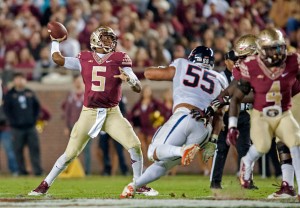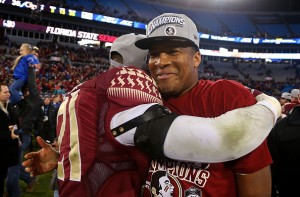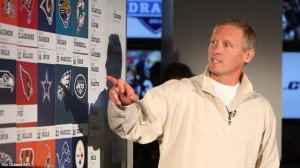If we’re being completely honest it’s becoming a bit tiring to talk about Jameis Winston at this point. That sounds hypocritical coming from the article that is currently writing about him, but keep in mind that we typically don’t devote entire articles responding to various claims made about Winston’s game or personal character. There’s a good reason for that: If there was a piece for every scorching hot take on Winston, there wouldn’t be enough time in the day to write them all. The last month before the draft gets inundated with outrageous speculation and fan-driven pipe dreams that are typically far removed from what teams are actually doing.
But there’s also the more egregious aspects of it all. Mainly the lengths that various people (both media and fans alike) will go to tear down a prospect they’ve been hearing about for months. Whether out of annoyance from hearing their name too much or just plain attention seeking, you can bet that there will be nitpickers who exaggerate weaknesses and downplay strengths for all types of players. Winston is certainly no exception.
That being said, there seems to be a couple of common tropes surrounding him that keep getting repeated. Winston has legitimate knocks on him. No rational person would deny that. But those knocks are often misunderstood or sometimes just not acknowledged and instead replaced by parroting of conjecture as fact.
“FSU had so much more talent than other teams, his performance is therefore concerning.”
This is admittedly more table talk than anything, largely because not many big media members have decided to go with this line of criticism. NFL Network’s Mike Mayock actually did this but we’ll talk about him later.

SYRACUSE, NY – OCTOBER 11: Rashad Greene #80 of the Florida State Seminoles runs with the ball into the red zone against the Syracuse Orange on October 11, 2014 at The Carrier Dome in Syracuse, New York. Florida State Seminoles defeat Syracuse Orange 38-20. (Photo by Brett Carlsen/Getty Images)
The first issue with this argument is that talent at its face level does not guarantee success. Various teams find themselves with top 25 recruiting classes yet have very little to show for it on the field. Obviously there is a correlation between getting quality players and becoming a quality team, but it should be noted that the argument bases itself off an assumption: That the talent FSU brings in will reach its full potential.
Even if we assume this to be true and we have reason to do so, the question of talent vs. experience rears its head. When was the last time a freshman wide receiver came out and dominated for FSU? Rashad Greene seems to be the only candidate after finishing with 596 yards and seven touchdowns in 2011. Keep in mind that he is one of the greatest receivers in FSU history and statistical leader in many major career categories. Hence why he was Jameis’ first option and they connected so much over their careers.
The point is that it’s rare to see young receivers come out and immediately surpass their older teammates. Yet Jameis Winston had both Ermon Lane and Travis Rudolph — both true freshmen — getting major playing time. His only other reliable option was Nick O’Leary, who had yet another fantastic year as one of the nation’s top tight ends.
At first, it sounds like I’m giving the criticism legs, because I’m mentioning two guys in O’Leary and Greene, who should seemingly have made the season much easier for Winston than it actually was. But the argument falls apart when you look closer into the numbers: Jameis was much better when targeting those two. While the stat is from before the Rose Bowl, Jameis averaged 14.7 yards-per-attempt targeting Rashad Greene and Nick O’Leary comparted to 5.9 yards-per-attempt while targeting all others.
But it doesn’t stop there. On Winston’s 25 touchdowns, 13 of those came when targeting the aforementioned two. On his 18 interceptions, only eight came when throwing to Greene and O’Leary. Two of them weren’t anyone’s fault because of missed pass interferences that allowed tipped passes to go right into the hands of the defender. Adjusting for those, Winston’s touchdown-interception numbers with Greene and O’Leary are 13-6. With everyone else, the adjusted numbers — subtracting three interceptions that weren’t his fault — come out to 12-7. That’s a fairly big difference when you’re talking about ratios and performance.
So in fact, Jameis did have more success with talent — veteran talent that is. Freshman wide receivers are still freshmen. They showed their potential but still had many flaws they needed to improve on. Faulting Jameis for young players being unable to immediately master a fairly complex offense seems to be a bit maligned.

TALLAHASSEE, FL – NOVEMBER 8: Quarterback Jameis Winston #5 of the Florida State Seminoles looks to make a pass against the Virginia Cavaliers during the game at Doak Campbell Stadium on November 8, 2014 in Tallahassee, Florida. The Seminoles beat the Cavaliers 34-20 (Photo by Jeff Gammons/Getty Images)
“A huge part of his interceptions came when he was pressured.”
For some reason this talking point has entered the conversation very recently and has somehow become a staple of Jameis fault-finding. While there doesn’t seem to be a film of it on the internet yet, ESPN’s Merril Hoge had a scathing review of Winston on NFL Live, saying that his inability to handle pressure led to many of his interceptions. I’m wondering what tape he was looking at.
Going down the list of interceptions seems to hold a slightly different story. Five of his interceptions were due to pressure getting to him and forcing a bad pass. This includes interceptions from the Oklahoma State, Notre Dame, N.C. State, Wake Forest, and Louisville games. But pressure did not have near the effect that Hoge and others would have you think.
In fact, it doesn’t beat out the other more legitimate concern: Underneath defenders. Five of his interceptions came from either misjudging or just not noticing a guy beneath the route. The rest of his interceptions have various causes like wide receivers giving up on routes, poor attempts to fit a ball where it shouldn’t go and so on. So why did Hoge act like it was a bigger problem than it actually was? Quarterbacks tend to throw interceptions more when they are under pressure, that’s not new. So why is it being treated as a huge negative for Winston when the numbers show that it was one part of a multi-faceted topic? Is this really that big of an issue that it knocks Winston down a draft board?
Moreover, interceptions are only part of the discussion of quarterback pressure. When looking at sack numbers, Peter King writes that Marcus Mariota was sacked 23 percent of the time he was pressured, good enough for sixth-highest rate in the class. Jameis was sacked only 11.5 percent of his pressured drop backs, second-best in the class. It’s not hard to see why. Mariota seems to have some issues with space management in the pocket under pressure. The specific criticism is a bit down in the article, but I highly recommend reading the whole thing to get a better idea of the actual criticisms of Mariota. Then again, this isn’t about Marcus. He’s a great quarterback in his own right. It’s about the fact that this aspect of pressure seems to be ignored when talking about Winston in the pocket.
There are a few more lines that we could examine like strength of competition, roles in offense, but they’re generally more contested or have better arguments behind them. You don’t have to agree with them, but it must be admitted that they have at least some merit on the surface. The same cannot really be said for these two that have been addressed already.
What needs to be discussed a bit more are the people who keep their names in the headlines with these criticisms.
A lot of people were shocked at the fact that Mayock decided to move Mariota above Winston in his quarterback rankings this late in the process. Some take it as a sign that the Tampa Bay Buccaneers, who hold the top overall pick, are moving away from Jameis while others think it’s Mayock trying to gain notoriety. It is probably the latter.
To be clear, arguing Winston has an interception problem is not that controversial. Most FSU fans will admit that he tried to force things too often this past year. But how one evaluates these interceptions has to mean something.
Look at what he’s saying: Mayock is claiming that Jameis’ interceptions and off the field behavior have forced him to rank him below Mariota. But those issues have been discussed and known about since before the college football season ended. Why is the change suddenly coming now? There’s always the possibility that perhaps Mayock finally got around to a more in-depth film review that changed his opinion…but that seems unlikely.
Mayock is a guy who makes his name every year with the NFL Draft and his mock boards. Now we’re expected to believe that just 22 days before the draft he’s finally getting around to reviewing the two best quarterback prospects? To his credit, he hasn’t claimed this was the case. But then what is? If it’s a development based on each’s pro day, it still doesn’t make sense. Winston had a better pro day than Mariota — though that’s not saying much. Pro days are a fairly low rung on the ladder that is the draft process. With this in mind, the most likely conclusion is that the change is being used to stir the pot.
Beyond that, reporting about Jameis in general seems to have an odd effect on many journalists. Every website and publication wishes for people to view their content, including this one. But recently an influx of head-turning titles and non-sports related talk has been present with many writers.
Early Friday, Winston’s attorney David Cornwell spoke at Villanova’s Moorad Sports Law symposium. In his speech, he discussed Winston and his transition to the NFL, which of course included the issues surrounding his off the field concerns and general maturity. What was the quote grabbed by the media? Yep, this one. Within an hour, multiple media outlets took the one quote and used it as evidence that even his attorney didn’t believe Winston would make it in the league. Florida State fans should know by now that this wasn’t the case.
Some more quotes and context from Cornwell in the same speech — all from Joel Anderson’s page: “This league will chew you up, spit you out and keep going…We have to assist him in growing and developing as a man. And it’s not going to be easy…If he messes up again, he’s done…And so we talked about it and (Winston) said, ‘I want to meet’…I don’t see why it’s controversial that a 20-year-old doesn’t have the life experience to navigate the treacherous waters of being a professional athlete without avialling themselves of the resources available to them…The idea that standing alone, he’s ready to get into this shark-infested pool, it’s just crazy. I don’t understand why it’s news…I don’t think (Winston) is unique. I don’t think anyone is ready. No one is ready for this world when they come into it.”
That is drastically different from the original idea many outlets portrayed in the reporting. Thankfully many of them would include the rest of his remarks as they came, but it still brings out the ugly side of journalism. The fact that a website can deliberately mislead about the contents of their articles for the sole purpose of getting a page click is simply commonplace. There’s no use in getting into the larger debate about the effects of technology on this, but it’s still distressing. It happens every year and there is no reason to think it’s going away. Writers and reporters can say “I’m just repeating what the source said” but they know it’s an intellectually dishonest response. They know what the title implies and they know what it’s being portrayed as. That they wish to not admit to it is not the least bit surprising for some.

CHARLOTTE, NC – DECEMBER 06: Jameis Winston #5 of the Florida State Seminoles celebrates after their 37-35 victory over the Georgia Tech Yellow Jackets at the ACC Championship game on December 6, 2014 in Charlotte, North Carolina. (Photo by Mike Ehrmann/Getty Images)
Beyond that, it is also a recurring theme that many writers feel the need to inject their own socio-political views into whatever they’re writing about. It’s understandable that these topics will get brought up when talking about Winston and his legacy at FSU. What is not understandable is the lengths that some writers go to with delivering their personal messages in stories where it is not needed.
A game preview is not the place to be discussing the complexities of topics like sexual assault. Comments are their own thing and they are (largely) unable to be reasonably controlled by writers/reporters. But the fact that one can go looking for a postgame recap and find an essay on whether or not a coach’s comments were sexist is ridiculous. There will obviously be cases where players or coaches actually do say something that’s universally considered not acceptable. But those can be discussed in a whole other article with a whole other theme.
Perhaps this is a bit hypocritical. After all, this piece itself is discussing media interactions and issues surrounding them. But every once in a while it is necessary to remove yourself from your usual writing and examine what could be done better or changed altogether. It also helps that this piece set out to discuss the issue first and foremost in the title, making sure that readers know what they’re in for.
Jameis is not the first and will certainly not be the last to receive the current media treatment. It has been this way for years now and as referenced before, will likely not change. But there’s something to be said for websites and reporters that look to honestly evaluate a prospect based on what they see.
If Winston does not succeed in the NFL, it will be for various reasons. But throwing whatever you have at a wall and seeing what sticks is not the way to determine such reasons.






















